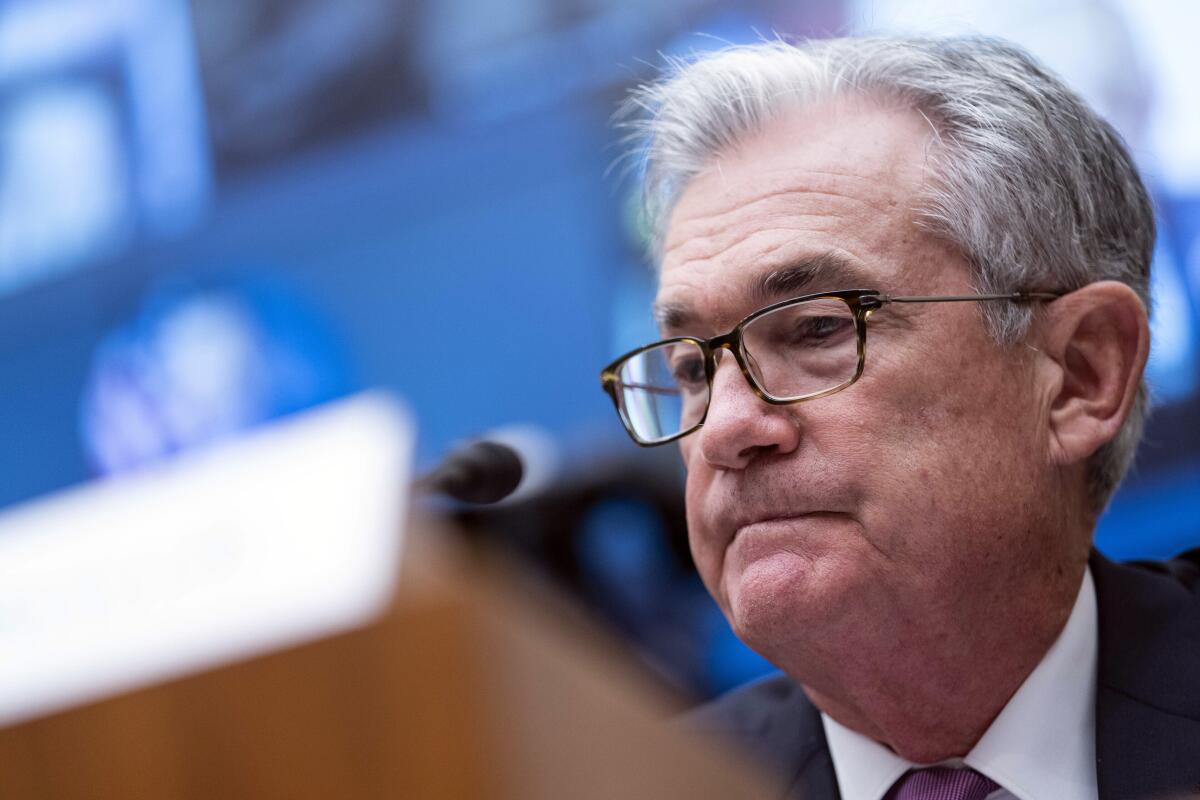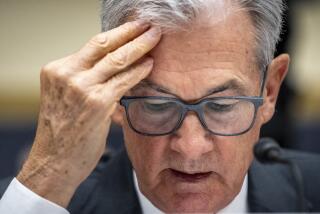Fed orders biggest interest rate hike since 2000 to combat inflation

- Share via
WASHINGTON — For the first time in 22 years, the Federal Reserve on Wednesday pushed up interest rates by a full half-percentage point — a significant escalation of its efforts to get control of troublingly high inflation.
The Fed action will raise costs for new borrowers and increase interest payments that many households, already stressed by higher prices for food and gas, are making on existing home equity lines, credit cards and some other loans.
And that’s probably just the beginning. Fed Chair Jerome H. Powell said Wednesday that additional half-point rate hikes were expected to be on the table at the central bank’s next two policy meetings, in mid-June and late July.
It’s part of a likely yearlong campaign to cool the economy after what now looks like too much monetary and fiscal stimulation during the COVID-19 pandemic.
The goal, more easily stated than achieved, is to slow growth without triggering a recession.
In addition to raising rates, its main lever, the Fed plans on June 1 to put its bond-purchase stimulus program in reverse, further tightening financial conditions by adding upward pressure on long-term yields and mortgage rates.
Many economists doubt the Fed can avoid a recession, but Powell argued that the U.S. economy was sturdy enough to absorb multiple rate hikes.
“Households and businesses are in very strong financial shape.... The labor market is very, very strong, and it doesn’t seem to be anywhere close to a downturn,” he said during a 45-minute news conference Wednesday afternoon, noting that there are two job openings for every unemployed worker.
Powell began the conference, his first in-person meeting with the media since early 2020, before the COVID-19 outbreak, by saying he wanted to tell the American people that the Fed was aware of the hardships that inflation was causing and that it had the tools and the resolve to restore price stability.
Stock markets rose sharply as Powell spoke, particularly after he stated that the Fed was not considering a bigger rate hike of 0.75 of a percentage point at an upcoming meeting, something Fed futures traders saw a high probability of happening in June.
Both the Dow Jones industrial average and the Standard & Poor’s 500 index, which were down earlier in the day, ended Wednesday with the biggest gains since 2020. The Dow closed up more than 900 points, or 2.8%, and the S&P 500 jumped 3%.
Fed officials, facing widespread accusations that they waited too long to raise rates, have been signaling for weeks that they want to move more aggressively in response to surging consumer prices, which jumped 8.5% in March from a year earlier.
That’s the highest since 1981, and record numbers of consumers now say inflation is their family’s top financial problem.
Mortgage rates already are up sharply in anticipation of Fed actions, and financing costs for auto and other loans also have crept higher. For retirees and other savers, the Fed rate hikes mean they will see higher returns on certificates of deposit and savings accounts, which have been minuscule for years.
On Wednesday, the average yield on a one-year CD was just 0.22%, according to Bankrate.com, and that’s up from 0.14% at the start of the year.
“Yeah, I am kind of devastated when I can’t even get 1%,” said Sherry Pietras, 64, a retired aerospace engineer in Huntington Beach.
For some economists, the concern is that the Fed, in its ramped-up campaign to get inflation back to its 2% target, will apply the economic brakes too hard.
“The market is way too optimistic about the Fed’s ability to tame inflation,” said Nancy Davis, founder of Quadratic Capital Management in Greenwich, Conn. “The Fed is hiking aggressively into a weakening economy.”
Others worry that the Fed will back off too soon at signs of trouble, and end up not doing enough to arrest high inflation.
“A mild recession may be the price that has to be paid to put inflation back in the box,” said Greg McBride, Bankrate.com’s chief financial analyst.
The U.S. economy grew last year at the fastest pace since 1984 as it recovered from the pandemic shock. The job market has been resilient. But with the war in Ukraine and continuing supply chain problems, not to mention lingering effects from the pandemic, the economy is showing signs of softening.
Investors are nervous, evidenced by the recent sell-off in risky assets, and some measures of consumer sentiment are now as bad as they were during the Great Recession, despite relatively healthy household balance sheets and an unemployment rate that’s near a half-century low.
The jobless rate in March was 3.6% and the economy has added an average of more than 560,000 jobs a month in the first quarter. April’s employment report will be released Friday.
“You can’t have a recession without payroll employment falling,” said Christopher Rupkey, chief economist at Fwdbonds. But he added that the picture could change quickly. “Even though it’s rising today, it could be falling two months from now.”
The Fed, in its policy statement Wednesday, noted that consumer spending and business investment remained strong, despite the downturn in economic activity in the first quarter.
The statement, however, warned that Russia’s invasion of Ukraine and related events “are creating upward pressure on inflation and are likely to weigh on economic activity.” What’s more, it said, COVID-19 lockdowns in China are likely to worsen supply chain problems.
Earlier in the year, Powell and his colleagues had suggested they were likely to raise rates more gradually, a quarter of a point at a time.
Now, the Fed appears determined to normalize monetary policy as fast as possible. Even with Wednesday’s announcement, the Fed’s main rate would still be below 1%. Most Fed officials think a normal, or neutral, rate is about 2.5%. Powell said the Fed could raise rates above that level, and some analysts see that occurring by year’s end.
The last time the Fed raised rates by half a percentage point was in May 2000, near the height of the so-called dot-com stock bubble, which burst that year and led to a relatively short recession in 2001.
More to Read
Get the L.A. Times Politics newsletter
Deeply reported insights into legislation, politics and policy from Sacramento, Washington and beyond. In your inbox twice per week.
You may occasionally receive promotional content from the Los Angeles Times.











